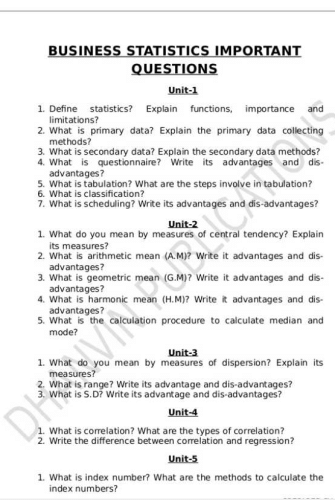B Com Exam > B Com Questions > I want business statistics notes of bcom?
Start Learning for Free
I want business statistics notes of bcom?
Most Upvoted Answer
I want business statistics notes of bcom?
Business Statistics Notes for BCom
Business statistics is a branch of statistics that deals with the collection, analysis, interpretation, presentation, and organization of data for making business decisions. It plays a crucial role in various aspects of business, such as marketing, finance, operations, and strategic planning. Here are some key points regarding business statistics:
Business statistics is essential for businesses to make informed decisions and gain a competitive edge in the market. Here are some key reasons why business statistics is important:
Business statistics has numerous applications across various business functions. Some common applications include:
In conclusion, business statistics is a vital tool for businesses to analyze
Introduction to Business Statistics
Business statistics is a branch of statistics that deals with the collection, analysis, interpretation, presentation, and organization of data for making business decisions. It plays a crucial role in various aspects of business, such as marketing, finance, operations, and strategic planning. Here are some key points regarding business statistics:
- Data Collection: Business statistics involves the process of collecting relevant data from various sources, such as surveys, questionnaires, observations, and databases.
- Data Analysis: Once the data is collected, it is analyzed using statistical techniques to identify patterns, trends, and relationships.
- Data Interpretation: The analyzed data is interpreted to draw meaningful insights and make informed business decisions.
- Data Presentation: The results of the analysis are presented in a clear and concise manner using charts, graphs, tables, and other visual aids.
- Descriptive Statistics: Descriptive statistics involves summarizing and organizing data using measures such as mean, median, mode, standard deviation, and variance.
- Inferential Statistics: Inferential statistics uses sample data to make inferences or predictions about a larger population.
Importance of Business Statistics
Business statistics is essential for businesses to make informed decisions and gain a competitive edge in the market. Here are some key reasons why business statistics is important:
- Forecasting: By analyzing historical data, businesses can forecast future trends and make accurate predictions about consumer behavior, market demand, and sales.
- Performance Evaluation: Business statistics helps in evaluating the performance of products, services, marketing campaigns, and overall business operations.
- Risk Analysis: Statistical techniques enable businesses to assess and manage risks associated with investments, financial decisions, and market fluctuations.
- Quality Control: Statistics is used to monitor and control the quality of products and services, ensuring customer satisfaction and loyalty.
- Decision Making: Statistical analysis provides insights and evidence-based information that aids in effective decision-making for business growth and profitability.
Applications of Business Statistics
Business statistics has numerous applications across various business functions. Some common applications include:
- Market Research: Statistics is used to analyze customer preferences, behavior, and market trends to develop effective marketing strategies.
- Financial Analysis: Statistical techniques such as ratio analysis and trend analysis help evaluate financial performance, profitability, and solvency of a business.
- Operations Management: Statistics is used for inventory management, production planning, quality control, and supply chain optimization.
- Human Resource Management: Statistics helps in analyzing employee performance, productivity, turnover rates, and designing compensation packages.
- Forecasting and Demand Planning: Statistical models are used to forecast demand, plan production schedules, and optimize inventory levels.
In conclusion, business statistics is a vital tool for businesses to analyze

|
Explore Courses for B Com exam
|

|
Similar B Com Doubts
I want business statistics notes of bcom?
Question Description
I want business statistics notes of bcom? for B Com 2024 is part of B Com preparation. The Question and answers have been prepared according to the B Com exam syllabus. Information about I want business statistics notes of bcom? covers all topics & solutions for B Com 2024 Exam. Find important definitions, questions, meanings, examples, exercises and tests below for I want business statistics notes of bcom?.
I want business statistics notes of bcom? for B Com 2024 is part of B Com preparation. The Question and answers have been prepared according to the B Com exam syllabus. Information about I want business statistics notes of bcom? covers all topics & solutions for B Com 2024 Exam. Find important definitions, questions, meanings, examples, exercises and tests below for I want business statistics notes of bcom?.
Solutions for I want business statistics notes of bcom? in English & in Hindi are available as part of our courses for B Com.
Download more important topics, notes, lectures and mock test series for B Com Exam by signing up for free.
Here you can find the meaning of I want business statistics notes of bcom? defined & explained in the simplest way possible. Besides giving the explanation of
I want business statistics notes of bcom?, a detailed solution for I want business statistics notes of bcom? has been provided alongside types of I want business statistics notes of bcom? theory, EduRev gives you an
ample number of questions to practice I want business statistics notes of bcom? tests, examples and also practice B Com tests.

|
Explore Courses for B Com exam
|

|
Suggested Free Tests
Signup for Free!
Signup to see your scores go up within 7 days! Learn & Practice with 1000+ FREE Notes, Videos & Tests.




















